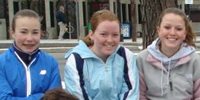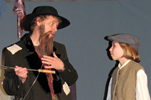Brief History of our Church
The tower of the Trinitarian Church rises up some 145 feet, a North Andover landmark since 1865. Beneath it a congregation comprised of all ages meets regularly to support and encourage each other through various ministries of corporate worship, of group study, of Christian fellowship, and of meaningful service. It is a community of faith - a people on a spiritual journey - a "family with a long history and a noble calling."
Its history is correctly traced to the very beginnings of the town of Andover (the earliest settled section of which is now North Andover), and to those earliest of settlers who, as early as 1646, brought their Puritan faith to this area. The religious devotion of these sturdy pioneers promptly led them to establish the First Church in Andover (later to be known as the North Parish Church), that, for many decades, was the only church in this early colonial town.
However, the subsequent 180 years brought considerable change in the religious climate, and the majority of the members in that First Church (by then known as the North Parish Church) came to espouse the theology of Unitarianism. As the differences in theology intensified, many of the members who continued to hold to the more traditional faith of their predecessors, came to withdraw from the North Parish Church and, with the encouragement of Jedekiah Farnham, a deacon of the North Parish Church, subsequently formed the Evangelical Church of North Andover, later to be known as the Trinitarian Congregational Church. Ministerial leadership for the newly formed congregation was abundantly provided by students and faculty of the nearby Andover Seminary (the oldest Protestant graduate school of theology in this country), located at that time on the campus of the Phillips Academy in Andover.
Many of the seminarians who walked across the fields in those years to superintend and to teach in the Sabbath School went on to become well-known religious leaders, leaving the tradition of a strong tie between Trinitarian Church and Andover Seminary (now the Andover Newton Theological School).
The first meeting house to be built by the newly formed congregation was dedicated in 1834. It was located near the site of the North Parish Church. The congregation soon outgrew that building, however, and decided to build another. Since a great amount of the support for the newly formed congregation was, by that time, derived from the owners of the Machine Shop, and since many of its members resided in the newer part of the town in which it was located, the decision was to locate the new building there.
Accordingly, it was erected in 1865 at the center of what came to be known as "The Machine Shop Village" (listed recently on the National Register of Historic Sites). The original part of the building was constructed at a cost of $25,000, four-fifths of which was subscribed by three owners of the "shop." Architect for the building was the highly reputed John Stevens of Boston, who designed a number of the imposing wooden churches of New England, including the South Church in Andover (1861 ).
By 1885, an estimated 60 percent of the town's population either attended the Trinitarian Church (known unofficially as "the Brown Church" by reason of the brown paint which covered its exterior until the mid-twentieth century), or held family pews in it. When in 1896 the town held its 250th anniversary, Trinitarian Church was the site of the town's all-day festivities. The church's close relation to the Davis and Furber Machine Company continued throughout the first half of the twentieth century, as did also the company's annual contribution of $1 ,000, begun in 1897. By the 1950's, however, that relationship became more historical than contemporary as the church came to be comprised more largely of persons with none of the earlier Machine Shop associations. With the arrival of Western Electric and Bell Laboratories in North Andover, Trinitarian Church received a number of new families to strengthen it sizably and to provide it with some of its very fine leaders. Today, the congregation is representative of the diversity which marks the town's population: no industry or occupation is predominantly represented among its membership as in the past.
Trinitarian Church has the tradition of a very strong music ministry. In 1988 the church installed a 24-stop tracker organ, rebuilt by the Andover Organ Company and designed by the then-organist of the church Bradley Rule. Only a few years prior to that, the late Sarah M. Field presented a Steinway Grand Piano (7 -foot) to the church in memory of her family. And at approximately the same time, the church acquired a 3-octave set of handbells. Each of the instruments is used under the very skilled and inspiring leadership of the church's minister of music and the loyal participation of a corps of volunteers.
Trinitarian Church is the trustee of a notable material history: a spacious and attractive house of worship and fine musical instruments dedicated to the praise of God. But its real history is in all of those persons whose prayers and whose Christian devotion are with it to this day. And that history is still in the making as people of faith continue to gather under its steeple to live out a faith that honors the gifts of the past and embraces the promise of the future.
Stained Glass Windows within the church were created by Charles J. Connick of the Connick Glass Studio of Boston, MA, in 1933.






